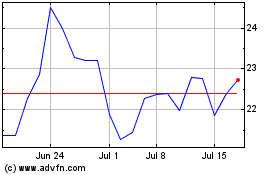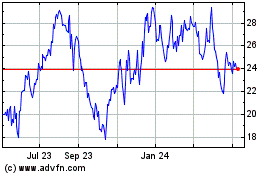UPDATE: Wal-Mart May Help Usher In Permanent Free Online Shipping
November 11 2010 - 5:55PM
Dow Jones News
By offering totally free shipping for online purchases during
the holidays, Wal-Mart Stores Inc. (WMT) has unveiled a strategy in
the battle for e-commerce business that may become a standard for
other retailers.
The combination of the world's largest retailer setting a
precedent in terms of depth of offerings and suggesting it may
follow with other free shipping deals creates a major competitive
pressure for retailers -- for this holiday season and beyond.
Wal-Mart on Thursday announced it will provide free shipping for
more than 60,000 online items during the holidays without the need
for a minimum purchase or subscription plan.
The move comes as other retailers at least mull over the
prospect and may help expedite the process.
"Shipping is clearly an element of the customers' decision, and
we need to be competitive in all those elements," Kohl's Corp.
(KSS) Chief Executive Kevin Mansell said in an interview with Dow
Jones Newswires. "We have not formalized our marketing strategy,
but we plan to be competitive."
Kohl's is already offering free shipping for all of its
merchandise "periodically" during the holiday season, Mansell
said.
Amazon had set the online standard with its popular Prime
program, which allows repeat customers to receive free shipping on
most purchases for an annual fee of $79. Prime has been so popular
that a group of retailers like Toys "R" Us Inc. and Barnes &
Noble Inc. (BKS) recently teamed up to introduce a competitive
shipping program called ShopRunner.
Now some a growing number of retailers are moving to free
shipping this holiday season, as well as having periodic free
shipping promotions year-round.
Apparel retailer L.L. Bean Inc., for example, is currently
offering free shipping and handling for its standard delivery
service in the U.S. through Dec. 20.
"For the largest retailer in the world to lay down the gauntlet
makes everyone in retail have to think about how what they offer
compares," said Noam Paransky, retail strategist at Kurt Salmon
Associates. "I would say at this moment retailers are evaluating
just how economically they can provide something, or something
similar, to what Wal-Mart is doing," which also includes free
returns.
Free shipping has been undergoing "an evolution" that started
when these promotions were first offered on Cyber Monday, the first
Monday after Thanksgiving, which is a big online sales day, said
Andrew Lipsman, an analyst at ComScore Inc. (SCOR), an e-commerce
analysis firm.
"At this point, there is a building expectation for free
shipping," Lipsman said. "If retailers don't get in the game they
risk losing consumers to their competition."
Some 41% of online retail transactions included free shipping, a
recent ComScore study showed, and 55% of shoppers said they would
abandon their cart if free shipping was not offered.
There is certainly incentive for retailers to at least step up
their free shipping efforts, given how important online buying has
become. Nontravel related e-commerce sales in the U.S. for this
year were $99 billion through the end of the third quarter, or
about 7% of overall retail spending, ComScore said. The amount is
more than double online sales' share from six years ago and
continues to show growth, including for brick-and-mortar
retailers.
Macy's Inc. (M), for instance, said on Wednesday that online
sales for its macys.com and bloomingdales.com sites rose 24% in the
third quarter compared with the year earlier. Overall sales grew a
comparatively tepid 6.6%, although in-store sales still make up the
lion's share of brick-and-mortar retailers' revenue.
Wal-Mart's website is already a very popular online destination.
In the third quarter, the retailer's online site averaged 37
million visitors, up 13% from the year before, according to
ComScore. The number places Wal-Mart third behind Amazon.com Inc.
(AMZN) and Apple Inc. (AAPL), including its iTunes store.
But retailers also have to consider the economics as they push
onto the Web. While many have built distribution centers devoted to
filling online orders, which lowers costs, there are still charges
for things like running the centers, shipping and processing. And
until now, retailers have largely avoided eating those costs. They
were passed along to customers in the form of shipping fees.
But with consumer demand still a bit tepid because of the
uncertain economy, retailers may have to rethink what is a
significantly growing, and therefore, very important business for
them.
-By Karen Talley, Dow Jones Newswires; 212-416-2196;
karen.talley@dowjones.com
(Scott Morrison contributed to this report.)
Kohls (NYSE:KSS)
Historical Stock Chart
From Jun 2024 to Jul 2024

Kohls (NYSE:KSS)
Historical Stock Chart
From Jul 2023 to Jul 2024
